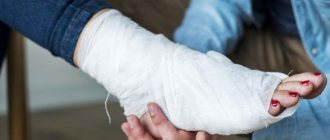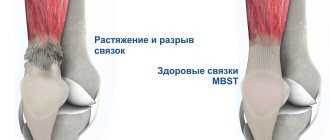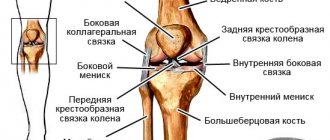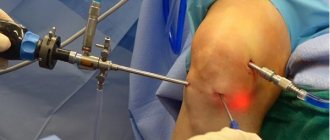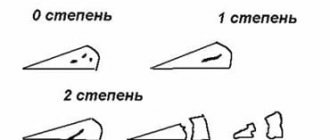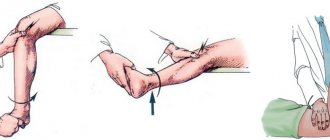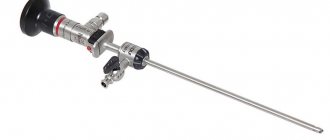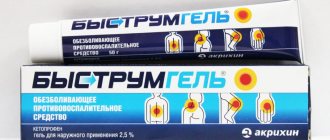The ankle is the part of the foot that is located next to the heel or femur bone. This joint is medically called the ankle joint. Ankle sprains are the most common among athletes. This is also a common home injury. Microcracks and breaks appear in damaged connective tissue fibers. Blood and intercellular exudate begin to collect inside. As a result, an environment is created that promotes the progression of the aseptic inflammatory process.
Sprained Ankle: Causes
The main cause of an ankle sprain is when the foot dislocates outward or inward. There are several main reasons that contribute to injury:
- weak ligamentous apparatus;
- domestic and sports injuries;
- Inconvenient shoes, often unstable (these may be high-heeled shoes);
- incorrect or poor fastening of sports equipment (athletes are not allowed to lace up skates or spikes, roller skates or ski boots)
- excess weight;
- ankle joint diseases, including ankle osteoarthritis;
- Abnormal development of the musculoskeletal system (this could be, for example, congenital valgus foot, flatfoot).
Excess weight can sprain your ankle.
Ankle sprains are often the result of age-related changes in the joint. All these factors require special attention. Athletes must wear safety shoes securely to prevent foot injury.
How to strengthen your ankle?
If your legs hurt
Discomfort in the legs can be a symptom of various diseases that require urgent medical attention. Find out what leg pain means.
- While sitting on a chair, try writing the letters of the alphabet in the air with your toes. Repeat the same with the other leg.
- At least 20 times a day, while walking, focus on how the muscles and ligaments of your foot and ankle move. Try to keep every step controlled.
- Use your bare toes to grab various objects on the floor. Start with a rolled towel, gradually pulling it towards you. Pick up plastic cups, matchboxes, large buttons and coins.
- Gently press the sole of your foot against a stationary object in the four directions of ankle movement: up, down, in, out.
Severity of pathology and symptoms
Depending on the severity of the disease, dislocations are divided into three degrees. It is important to become familiar with the characteristics of each type in order to recognize the disease and take appropriate measures:
- First degree torsion. The patient has a small ligament tear. The patient feels slight pain and notices slight swelling.
- Second degree torsion. The foot ligament is partially torn. This form of injury causes moderate pain and swelling.
- Third degree torsion. The ligament is completely broken. When this injury occurs, severe swelling and sharp pain appear in the ankle area.
A ligament rupture requires immediate medical attention. You should definitely contact a traumatologist who will prescribe the appropriate diagnosis. This will help determine if there are other injuries.
Clinical symptoms may be mild and less pronounced. The full range of symptoms and signs of an ankle sprain begin 4 to 5 hours after the injury. Several main clinical symptoms can be identified:
- Severe to moderate ankle pain with sprained ankle ligaments;
- edema;
- internal hematoma or hemorrhage;
- limited joint mobility;
- the position of the ankle joint varies (dislocation can be detected during examination).
The severity of symptoms depends on the degree of damage to the ligaments. If you suspect an ankle sprain, consult a trauma surgeon.
Symptoms
When ligaments and tendons rupture, the following symptoms occur:
- soreness;
- pronounced swelling of soft tissues;
- subcutaneous hematoma (with damage to blood vessels);
- a sharp deterioration or complete inability of one or another group of muscles and/or joints to perform normal work;
- forced position of the limb.
The clinic may depend on how often the same structures are injured. Symptoms of rupture of the collateral ligaments of the knee joint may be more pronounced if the injury is repeated.
Sprained ankle: first aid and what to do?
If a patient has sprained their ankle and is experiencing severe pain, the following steps should be taken to provide first aid:
- A soft object is placed under the shin. The foot should be in an elevated position. This helps reduce swelling.
- Place ice on the injured area. This helps stop bleeding and slow down inflammation. Ice should not be kept for more than 20 minutes to avoid frostbite.
- A bandage should be applied to the injured joint to increase rigidity. It is shaped like a figure eight. This may be a simple or elastic bandage that is placed around the injured joint, covering the lower part of the lower limb. The bandage should not be made too tight so as not to interfere with free blood circulation.
- You are taking painkillers. The most effective drugs are Analgin, Ketanov, Diclofenac.
In order to get rid of pain from sprained ankle joints, you can take Katanov.
Even with a slight twist, ointments with a warming effect cannot be used. This list includes hot compresses and alcohol tinctures. Such drugs promote vasodilation and active blood flow. There is a high probability of developing an inflammatory process.
First aid for a fracture or sprain. The ankle joint requires quick action. Immobilize the patient's foot and call an ambulance. Do not move the injured leg when transporting yourself.
First aid
Jogging without pain
Most injuries sustained while running are caused by the runner himself. Learn how to avoid running injuries.
Immediate treatment for a torn ankle involves four main steps:
- Limited mobility
- Application of cold
- Applying a pressure bandage
- Elevating the injured limb
Swelling and pain in the ankle area is usually caused by edema, so this should be kept to a minimum. Try not to move
the injured limb for at least a day.
Apply ice
wrapped in a thin towel to the ankle area.
To avoid frostbite, do not leave ice in one place for more than 20 minutes. It is enough to apply cold for 20 minutes every two hours during the first 24 hours after injury to significantly reduce the likelihood of swelling. To limit mobility in the ankle joint, wrap your ankle with an elastic bandage
.
It should cover the foot from the toes and end at the shin. Lie down and elevate your injured leg
above the level of your heart to allow blood to flow out. If swelling does not go away or you are unable to put weight on your foot within 48 hours, be sure to seek medical attention. Returning to active sports activities is possible only after the complete disappearance of pain and limited mobility in the ankle. It is better to start classes with regular light warm-up exercises that do not require a large range of motion of the ankle.
Ankle Sprain: Diagnosis
The diagnosis can only be made by a doctor who has ordered the appropriate tests. The most informative research methods are radiography and arthrography with contrast. Contrast liquid is injected into the damaged joint. An MRI may be performed to determine the location of the injury.
- X-ray examination is carried out in two projections and positions. The diagnosis is made based on information about the angle of inclination of the plate.
- During arthrography, a contrast agent penetrates the site of the ligament tear. The photo clearly shows areas of deformation.
- Magnetic resonance imaging shows the extent of damage to the ligaments, as well as the current condition of the cartilage. A specialist will be able to assess the injury and also look for additional damage.
X-ray is one of the methods for diagnosing ankle sprains.
All these diagnostic methods are the most informative; they will be able to show you all the damaged areas.
Diagnostics
The diagnosis is made based on examination and stress tests. Sometimes additional examination methods (instrumental and laboratory) are used to identify damage to other structures. Before treating a torn meniscal ligament, you need to make sure that the meniscus itself is not damaged.
Stress tests represent a certain load on the ligaments and tendons - such tests help determine which specific elements are damaged. When performing the test, the patient must abduct the joint in a direction that is opposite to the natural direction.
Due to severe pain during the test, muscle spasm may occur, which will not allow the instability of the limb fragment to be detected. To avoid inaccurate results, you should wait until the muscles relax as much as possible and repeat the test. If muscle tension is severe, pain relief should be administered, and then the test should be repeated. It is necessary to test all ligaments and tendons if there is a suspicion that more than one group has been damaged. Diagnosis and treatment of knee ligament rupture may be combined with diagnosis and treatment of Achilles tendon rupture.
Simultaneously with testing the affected limb, the healthy limb is loaded, the results are compared:
- in case of 1st degree ruptures of joint function - in the same volume, but the functional load is painful;
- in case of II degree ruptures, the pain during the performance of functions is severe, the functions of the joint are limited;
- with third-degree ruptures, the pain is weaker. This is because the ligaments or tendons are completely torn and are not strained during testing.
Sprained Ankle: Treatment Methods
In most cases, ankle sprains are treated conservatively. Patients will be able to carry out treatment at home. Surgical intervention is indicated for rupture of the deltoid ligament, as well as injury to the intercostal joint. It is recommended that you consult with a trauma surgeon to learn how to treat an ankle sprain.
Medication
When the muscles of the ankle joint are sprained, patients are prescribed non-steroidal anti-inflammatory drugs. He also prescribes painkillers that can relieve pain and inflammation. They come in the form of injections, ointments and tablets.
If you have a grade 1 ankle sprain, you should cool the injured area for 24 hours. Ibuprofen, Nimesil, Ketanov, Ortofen, Tempalgin are used as effective drugs. On the third day, you can use anti-inflammatory and warming ointments. Doctors often prescribe Apisatron or Capsicum.
Swelling is relieved with Troxevasin and Venitan ointments. These drugs do not have a negative effect on the body unless the patient has an allergic reaction. Their action is based on local effects.
The fixation bandage should be worn for at least three weeks. Drug treatment is often supplemented with the application of a plaster cast. Initially, the patient should remain in bed. The leg is placed in an elevated position to ensure blood flow.
Operational
For grade 2 and 3 ankle ligament damage, surgical treatment is recommended. During surgery, the doctor makes an incision to visually assess the condition of the cartilage. The ends of the damaged ligaments are then sutured. If the ligament is completely separated from the bone, it must be reattached. The wound is sutured and a bandage is applied for 7-10 days.
| Advantages | Disadvantages of the operation |
| It is possible to connect the damaged ends of the ligaments | Scars |
| Removal of hematoma | Damage to nerve endings |
| Additional and better examination of the injured joint | Long rehabilitation period |
| The need to dress a wound incision | High medical costs |
Traditional methods
Traditional medicine can be used as an addition to drug therapy. Consult your doctor before starting. The following effective methods of treatment using traditional medicine can be distinguished:
- Hot milk wrap. Helps quickly relieve pain from ankle sprains. The compress should be replaced as it cools.
- Onion. You need to take two medium onions, pass them through a meat grinder and mix with 1 tablespoon of salt. The resulting porridge is placed on gauze and placed on the sore area. It is recommended to insulate the area with a woolen scarf. Salt helps to quickly and safely remove fluid that accumulates in the injured area. With regular use, it reduces swelling and inflammation.
- The sand is poured into a bag made of natural fabric and heated in the oven. Apply a hot compress to the sore leg. The duration of the procedure is 10-15 minutes. Repeat every 60 minutes. Hot compresses are applied on the third day after injury.
Hot sand wrap is one of the traditional methods for treating a sprained ankle.
Doctors advise their patients to make compresses from tea infusion. Helps relieve discomfort, pain and swelling from sprains. cubes. Change the compress as it dries.
Rehabilitation period
The duration of the recovery process depends on the severity of the injury. For a grade 1 sprain, the patient will have to stay in bed for a week. In case of second and third degree injuries, the patient will have to follow the doctor's instructions for 2-3 months.
To quickly recover, you need to do gymnastics and special exercises. Their action is aimed at strengthening the ankle joint and injured muscles.
Physiotherapy
Physiotherapy is widely used to treat this type of injury. To improve the result, the patient needs to perform the LFC complex. During therapeutic exercises, the doctor demonstrates and monitors compliance with the technique.
Physiotherapy includes the following techniques:
- Exposure of the body to high-frequency electromagnetic fields. This procedure helps relieve swelling, normalize blood flow and speed up healing.
- Calcium electrophoresis. The effect on the damaged area occurs at the cellular level.
- Phonophoresis with hydrocortisone. The patient is administered drugs that begin to act actively under the influence of ultrasonic waves.
- Paraffin therapy. The ankle joint is heated with paraffin. Hot compresses promote active regeneration of soft tissues.
Patients are recommended to be treated in a mud bath. This therapy promotes rapid reconstruction of damaged ligaments and muscles.
Gymnastics
Therapeutic gymnastics promotes the development and restoration of normal functioning of the ankle joint. The following effective exercises can be distinguished:
- Walking around the room by straightening and flexing your toes.
- Raising your body on your toes. The exercise should be done at a slow pace. We bend the heels and straighten them in different positions.
- Resistance exercises. Additionally, use an eraser or other obstacles. They should be carefully pulled on top of each other.
Free running is part of the rehabilitation process.
For partial improvement, the patient needs to run at a slow pace for 5-10 minutes. During the process of healing and regeneration of the ankle joint, you can play with a ball or jump on the spot.
Complications and prognosis
Complications of an ankle sprain often occur late or early after the injury. The following pathologies can be identified that occur immediately after a sprain:
- Dislocation of the joint;
- Hemarthrosis (accumulation of blood in the joint cavity);
- the formation of a purulent hematoma in the joint.
Complications in the late period appear after 2 months. This could be arthritis, arthrosis, flat feet or joint instability. The prognosis for prompt treatment and recovery from an ankle sprain depends on the severity of the injury. It is important to seek medical help in a timely manner and follow all rehabilitation recommendations.
Degree of damage
Depending on the severity, the following degrees of ligament and tendon ruptures are distinguished:
- I degree – minimal gap;
- II degree – moderate and severe;
- III degree – complete.
Complete tendon ruptures are less common than ligament ruptures because they are stronger than ligaments—for example, ankle ligament ruptures are diagnosed more often than Achilles tendon ruptures. Complete rupture of the ligaments in most cases causes instability of the joint. Due to a complete rupture of the tendon, the muscle ceases to function because it is not attached to the bone.
Ligament and tendon ruptures most often occur in:
- athletes (for example, football players are often diagnosed with a rupture of the anterior cruciate ligament, which stabilizes the knee joint);
- victims of accidents.
Most often, partial or complete ligament ruptures are diagnosed:
- acromioclavicular joint;
- proximal interphalangeal joints (PMFP - joints between adjacent phalanges of the fingers and toes, which are located closer to the center of the body);
- knee joint;
- ankle joint;
- Achilles tendon. Partial rupture of the Achilles tendon is a common sports injury.
Tendon ruptures are most common for:
- knee extensors;
- calcaneal (Achilles) tendon.
Often, when an injury occurs, ligaments and tendons rupture - for example, when the extensor tendon of the hand ruptures, the ligaments of the hand are damaged.

